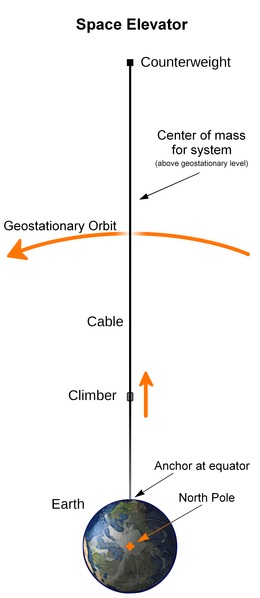Space elevator – a distant reality?

Space elevator, sometimes referred to as beanstalks, space bridges, space lifts, space ladders, skyhooks, orbital towers, or orbital elevators; is a proposed type of space transportation system designed to permit vehicle transport along the cable from a planetary surface, such as the Earth’s, directly into space or orbit, without the use of large rockets. If this idea is realized, advocates say it could reduce the cost of access to orbit from its current level of $10,000 or so a pound to $100 a pound, which would revolutionize space travel and open the solar system to human settlement.
An Earth-based space elevator would consist of a cable with one end attached to the surface near the equator and the other end in space beyond geosynchronous orbit (35,800 km altitude). The competing forces of gravity, which is stronger at the lower end, and the outward/upward centrifugal force, which is stronger at the upper end, would result in the cable being held up, under tension, and stationary over a single position on Earth. Once deployed, the tether would be ascended repeatedly by mechanical means to orbit, and descended to return to the surface from orbit.

Concept of space elevator is not new, first suggested by Russian scientist Konstanin Tsiolkovsky in year 1895 to consider a tower that reached all the way into space, to an altitude of 35,790 kilometers (22,238 mi) above sea level . He was inspired by Eiffel Tower in Paris at that time. Though building a compression structure from the ground up proved an unrealistic task as there was no material in existence with enough compressive strength to support its own weight under such conditions. Later in 1959, Yuri Artsutanov, another Russian scientist suggested using a geostationary satellite as the base from which to deploy the structure downward. His theory was to use a counterweight and lower a cable from geostationary orbit to the surface of Earth, while the counterweight was extended from the satellite away from Earth, keeping the cable constantly over the same spot on the surface of the Earth.
In 1966 four American engineers, Isaacs, Vine, Bradner and Bachus, reinvented the concept and named it a “Sky-Hook,” published their analysis in the journal Science. They decided to determine what type of material would be required to build a space elevator, assuming it would be a straight cable with no variations in its cross-section, and found that the strength required would be twice that of any then-existing material including graphite, quartz, and diamond. Since then most ideas for space elevators are focused on tensile structures, with the weight of the system held up from above. Space elevators were also described in science fiction during 70s and later.
Major challenge is the ability of the cable to hold up, with tension, the weight of itself below any particular point. The vertical point with the greatest tension on a space elevator cable is at the level of geostationary orbit, 35,786 km (22,236 mi) above the Earth’s equator. This means that the cable material combined with its design must be strong enough to hold up the weight of its own mass from the surface up to 35,786 km. It remained an idea of science fiction as there was no material strong enough to suit for such cable.

Annual International Space Elevator Conference is organized every year, being held from 25th to 27th August this year at Seattle’s Museum of Flight. Also, there has been competitions organized by Spaceward foundation to speed up space elevator development, being held for climbers, ribbons and power-beaming systems, the Robogames Space Elevator Ribbon Climbing competition. In 2004, A privately held corporation, LiftPort group was found with objective of constructing space elevators using carbon nanotubes. In 2011, Google was revealed to be working on plans for a space elevator at its secretive Google X Lab location. Recently in 2012, the Obayashi Corporation announced that in 38 years it could build a space elevator using carbon nanotube technology.
Featured image: star-tech-inc.com

[…] Space Elevator https://watchers.news/2012/08/26/space-elevator-distant-reality/ […]